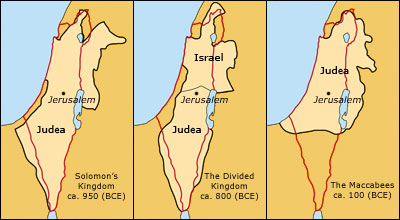| The
History
of Israel
- A Chronological Presentation

1.
Early Times (1000 BCE - 135 CE)
Ca. 1000 (BCE)
- The Jewish Kingdoms
King David ruled with Jerusalem as his capital over
Judea, the first united kingdom in an area, which roughly
corresponds to today's Israel including the West Bank.
After the death of David's son, Solomon, in 931 BCE
the kingdom was divided into a southern part, Judea,
and Israel in the north.
722 (BCE) - The Assyrians
The Assyrians, a powerful people from northern Mesopotamia
(today northern Iraq), invaded the northern Kingdom
of Israel and deported the Jews to other parts of the
Assyrian Empire. The Kingdom of Israel perished.
586 (BCE) - The Babylonians
After the fall of the Assyrian Empire the Babylonian
king, Nebuchadnezzar II, conquered Jerusalem. The most
influential Jews of Judea were deported to Babylon (in
southern Mesopotamia, today Iraq). The first Jewish
temple in Jerusalem was destroyed.

The
Kingdom of Solomon, the divided kingdom and Judea at
the time of the Maccabees (the exact borders are subject
to some uncertainty). The red line describes Israel's
current borders incl. Gaza, the West Bank and the Golan
Heights.
538 (BCE) - The Persians
King Cyrus of Persia (today Iran) conquered
the entire Babylonian Empire, allowed the exiled Jews
to return from Babylon, and accepted a form of Jewish
home rule in Jerusalem. The Jewish temple was rebuilt.
332 (BCE) - The Greeks
The Greek-Macedonian ruler Alexander the Great
destroyed the Persian Empire, thereby gaining control
over Judea. After the death of Alexander his Hellenistic
(Greek) Empire was divided into three parts, and the
Jews got squeezed between the competing Greek rulers.
164 (BCE) - The Maccabees
A Jewish tribe, the "Maccabees",
revolted against the Hellenistic occupiers, and from
142 BCE and the following 80 years Judea once again
was an independent, Jewish state.
63 (BCE) - The Roman Conquest
The Romans invaded Greece and also conquered
the Hellenistic Seleucid Empire in the Middle East.
Though the Jews were granted some measure of autonomy
in Jerusalem, Judea was in reality ruled from Rome.

A
model of Jerusalem at the time of the Second Temple.
37 (BCE) - Herod
The Great
Following a failed Jewish rebellion, the Romans
turned Judea into a regular Roman province, and installed
the Jewish King Herod the Great as administrator. After
his death in 4 BCE the province was divided between
Herod's sons. One of them, Herod Antipas, who is best
known for his role in the New Testament, administered
Galilee in the north and Perea to the east (the east
bank of the Jordan River, today part of the Kingdom
of Jordan).
70 - The
Destruction of Jerusalem
The Roman Emperor Titus quashed yet another
Jewish rebellion. The Jewish temple and the rest of
Jerusalem were reduced to rubble. A group of especially
persistent Jews sought refuge on the mountain of Masada
in the desert near the Dead Sea, but were three years
later defeated by the Romans.
135 - Judea Renamed
Palestine
During a final Jewish uprising against the
Romans (the Bar Kochva Revolt) Jerusalem was once again,
for a short, three-year period, under Jewish control.
After the Romans' inevitable, crushing victory many
hundreds of thousands of Jews were either deported,
sold as slaves or killed. The Roman Emperor Hadrian
leveled Jerusalem to the ground, and barred Jews from
entering the city.
In an attempt at definitively eliminating the Jewish
connection to the land, the Romans renamed Judea to
"Palaestina", a word believed to be derived
from the "Philistines", a people from Crete,
which a thousand years earlier roamed the Mediterranean
coast of Judea. Jews still lived in the area, though,
and less than 100 years later they were once again allowed
access to Jerusalem.

The
destruction of the Second Temple, 70 AD (by Francesco
Hayez, 1867).
Continue:
Chapter 1 - Early Times - Page 2
Back
|